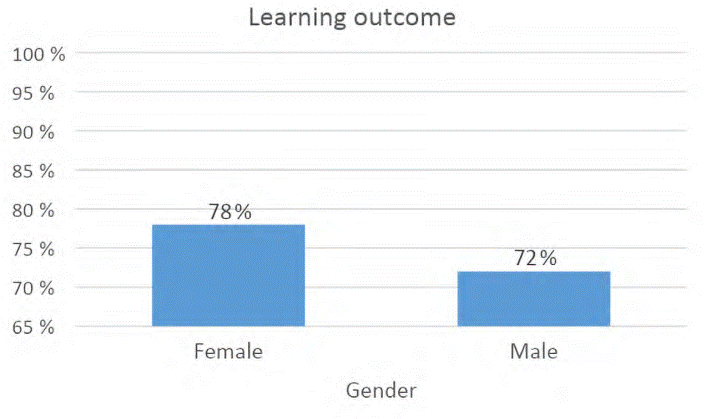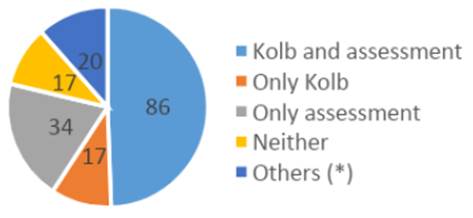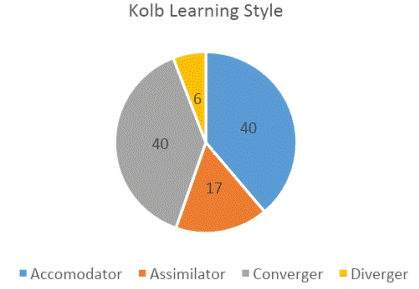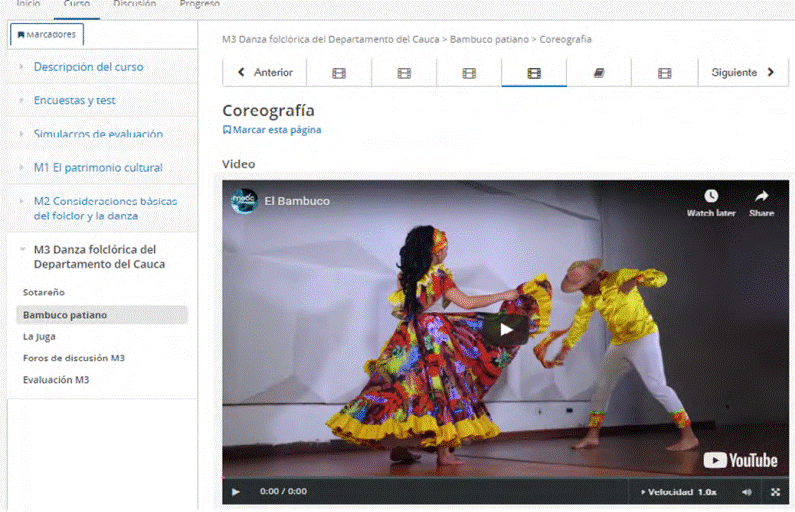INTRODUCTION
The “MOOCMenTES Project Capacity Building for the Management of MOOCs for professional Training, Rural Development and New Generations of Rural Students in Improving their Transition to Higher Education”, is developed by University of Cauca, and sponsored by the Colombian Ministry of National Education, within the framework of the Rural Plan for Higher Education for Rural Development and Peacebuilding [1]. The purpose of this project is the rural professional training in virtual environments and the transition to higher education from diverse rural contexts.
As a mediation strategy, and in order to reach the expected coverage of the project, it was agreed to create intensive contents in videos in MOOC/SPOC modality, oriented towards knowledge, promotion of rural development and production chains in universities, as well as its potential relationship to rural development in a context of diversity, nature, entrepreneurship and culture. To fulfill this goal, a series of online courses related to tourism and culture, among other topics.
To face this new challenge, the work team of the MOCMenTES project at University of Cauca, identified two in-person courses that work on cultural manifestations and contribute to the rescue and preservation of the culture in the state of Cauca: “Cultural Heritage” and “Recreational Folk Dance” . These courses are offered by the programs of Tourism and Physical Education, respectively, and despite the fact of belonging to different programs and schools, and being taught by distinct teachers with unrelated academic backgrounds, both courses share the fact of working on cultural manifestations.
The “Recreational Folk Dance” course, is offered to undergraduate students from University of Cauca at Popayán, Santander de Quilichao, and El Bordo, as a subject of “Physical Education”. This is a transversal course for all the undergraduate programs. Here, dance is approached from a practical and experiential perspective, which provides students with an opportunity for personal growth based on team work, exploration of playfulness, creativity and a basic dance component perspective, not from the technique, but from their own feelings as subjects where the corporeity and the motor skills are the foundational axes. This subject is developed in a rich cultural context, although a lack of knowledge about their cultural roots has been evidenced in the students. This has encouraged the rescue of identity through dance.
The “Cultural Heritage” course, is offered to students of the Tourism program at the School of Accounting, Economic and Administrative Sciences. It is characterized for dealing with conceptual foundations which aim at developing elements of judgment for the recognition, identification and valuation of the National Cultural Heritage, so students can project those elements in the design of specialized tourist products.
The common elements in the aforementioned courses are the cultural manifestations, since “Cultural Heritage” is approached from a theoretical perspective, recognizing that folk dances are one of these manifestations in the communities, and it is fundamental to recognize, rescue, conserve, and preserve them for future generations.
Given the characteristics of each of these courses and the elements that they have in common, it is possible to integrate them in just one massive online course, which would allow to expand coverage, as a contribution of the project MOCMenTES to the university.
The integration process of these two courses suggests a series of key elements, adaptations in the contents, activities and evaluation of the EDX platform where the courses will be designed and hosted. This process brings with it a series of challenges which are considered in this article.
1. CHARACTERISTICS OF A MOOC
MOOCs appeared in 2008 as the evolution of Open Educational Resources (OER), and are a proposal to universalize education and offer free and high-quality education to people who live in remote or disadvantaged areas. Inspired by Connectivism [2], an innovative educational theory proposed by George Siemens in 2005, MOOCs are characterized by offering free courses accessible through the Internet [3], from which a certificate of approval can be issued after payment [4], usually short-termed [5], focused on the contents -which must be openbasically of video type [6], complemented by other web-based learning activities, with relatively simple and automatic assessment activities [7], generally with no limit on the number of registered students [8] or with the ability to scale up to significantly high numbers of students.
In the creation process of this virtual course, it is important to consider that a MOOC (Massive Open Online Course) course is characterized for being offered through Internet platforms, generally with no prerequisites, and open to large numbers of students at a time [9]. Nowadays, MOOCs are a global phenomenon that is transforming teaching and making researchers reflect on new ways of learning in Higher Education Institutions (HEIs) worldwide. Since Dave Cormier coined the term MOOC in 2008, these courses have become the catalyst to change the traditional teaching/learning model of universities [10].
2. METHODS
2.1 MOOC Design: “Folk Dance as Cultural Heritage”
The MOOC Canvas proposed in [11] was used for the conception of the “Folk dance as cultural heritage” MOOC, as seen in Figure 1MOOC Canvas Project.
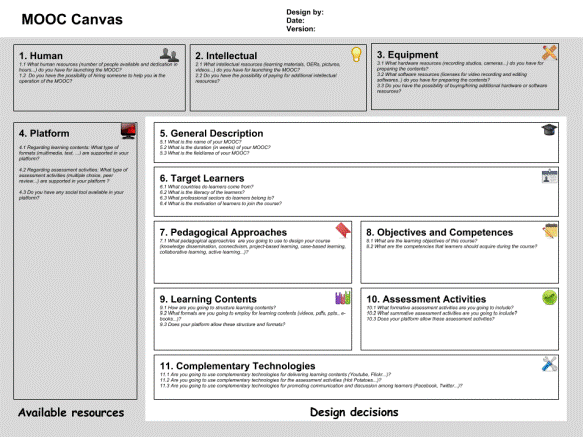
Source: [11]
Figure 1 MOOC Canvas Project. Source: Proposal for a conceptual framework for educators to describe and design MOOCs
2.2 Definition and creation of contents
For the specific design of the “Folk Dance as Cultural Heritage” MOOC, the guidelines proposed in [12] was followed. It is summarized below. According to the authors, a MOOC must:
Facilitate the understanding of contextualized basic concepts.
Promote the participation of students within the course activities.
Program the contents and learning activities in a progressive way, from the general to the particular.
Define easily accessible and achievable contents and activities.
Enable the increase of a significant number of students, including those who do not belong to this university.
Given that it is an integration of two in-person courses, a theoretical and a practical one, the work team defines that this MOOC must include the contents shown in Figure 2. Contents of the “Folk dance as cultural heritage” MOOC course.
The Folk Dance as Cultural Heritage course consists of three units: 1) Cultural Heritage; 2) Considerations about folklore and dance, and 3) Folk Dance in the State of Cauca: Central, Southern, and Northern regions.
Unit I: “Cultural Heritage” discusses general concepts about cultural heritage, its definition, classification and assessment, so students can associate dance as a cultural manifestation which is part of the intangible cultural heritage, as defined by the United Nations Educational, Scientific and cultural organization (Unesco), cited by [13].
Unit II, Considerations about Folklore and dance, starts contextualizing the students about the University of Cauca, its geographical location and history, as well as the definition and classification of its cultural manifestations, folklore and dance.
At the end, there is a proposal to include a third unit entitled “Folk Dance in the State of Cauca: central, southern, and northern regions”, which would include information about traditional dances delimited by regions due to the great multicultural wealth of this state. The selected dances for this unit would be: El Bambuco Patiano for the southern region, La Juga for the northern region, and El Sotareño for the central region. El Sotareño is a traditional dance from the capital city of the state. It would also include the history, costumes, music and choreography.
Considering that a MOOC is characterized for handling its contents in videos where teachers explain the topics of each unit, it is necessary to prepare the scripts to guide the teacher’s speech for the final recording. Each video is intended to last from 1 to 3 minutes to ensure that the students do not lose interest or attention in the class. 58 videos were recorded for this course.
2.3 Learning and evaluation activities
The learning activities were adapted from the in-person courses to a virtual environment, considering the characteristics of the platform that will host the MOOC, keeping in mind, for instance, that the reading controls and the forums are nongradable.
As the course is offered in a mass learning environment, the only feasible evaluation strategy is the one carried out through automatic grading services of the Open edX [14] platform. The basic guidelines for the design of the questionnaires were as follows:
Questions should be consistent with the objectives formulated for the course.
The mastery of comprehension and application skills should be verified according to Bloom´s Taxonomy [15] rather than simple knowledge.
Questions that can be answered with simple searches through an Internet browser should be avoided as far as possible.
Three different questionnaires were done. Each one with at least 10 questions, which can be taken at three different times, in order to avoid fraud, or at least, to make it more difficult
3. OUTCOMES
3.1 Learning outcomes in a Pilot test
The Folk Dance as Cultural Heritage course is currently being developed as a pilot, a test of learning styles was applied to the students at the beginning of the course, and an exam was given at the end of the first unit (Introduction to Cultural heritage), to assess the learning results. These results were considered to design a 2.0 version of the course, in a way to explore a pedagogical impartiality concerning the learning styles.
The use of the Open edX platform allows the obtention of statistical information, which is useful to understand the effect on learning of the strategy used for the design and delivery of the course. Figure 3 shows that women perform better than men.
Figure 4 illustrates the development of some activities by the students. Out of 174 students registered for the course, 120 submitted an assessment. Out of that amount, 86 could be identified as having a basic learning preference according to Kolb Learning Styles Model [17]. 17 other students with the same characteristics did not respond to any exam. 20 students took the Kolb test but did not have an identifiable dominance.
The Accommodator and Convergent learning styles were the most frequent (40 each), as shown in Figure 5.
Similarly, as shown in Figure 6, the Convergent style followed by the Accommodator style were the best performers (78 % and 76 %, respectively), followed by the Assimilator and Divergent style (70 %). This indicates that the course design is favoring students who prefer Active Experimentation as a form of information processing, according to Kolb´s Model.
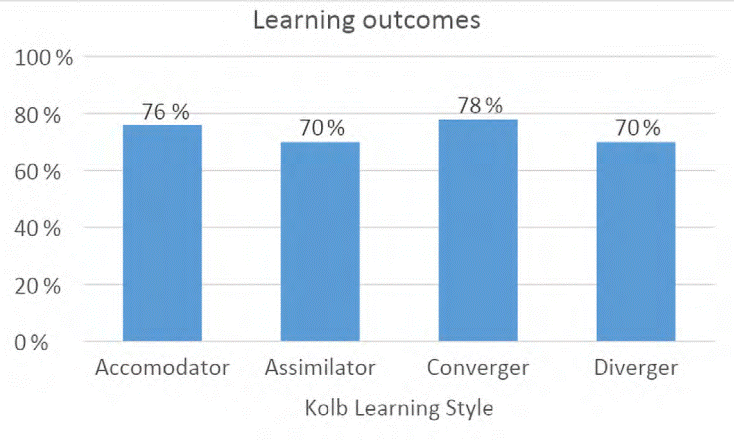
Source: Taken from www.seleneunicauca.edu.co. [16]
Figure 6 Learning outcomes vs. Kolb’s Learning Style.
4. DISCUSSION
4.1 Challenges
The experience of integrating two in-person courses, one theoretical and one practical, in order to create a virtual course, brought with it several challenges. One of the most complex challenges was related to seeing the teaching of folk dance from a different perspective to the traditional face-to-face modality as it has been offered so far at University of Cauca, which implies adjustments in its contents, activities and evaluation.
Considering the limitations of the platform in which the course will be hosted, and the characteristics of the contents that must be handled in a MOOC course, the dance topics will be approached from a theoretical perspective. It is here where another challenge arises: the construction of a theoretical base of the folk dance, since the courses of the “Physical Education” program are completely practical and experiential, so no theory is taught in them. During the search of theoretical references, it was found that some authors write about music, but not about dance, and there was no literature on folk dance in the State of Cauca. For this reason, the theoretical research was approached from the oral tradition of the inhabitants in each municipality where the subject is taught: Santander de Quilichao, Popayán and El Bordo (Patía). This situation made it difficult to select the theoretical topics about dance that were going to be taught in the course.
The adaptation of the practical contents of the dance course to theoretical contents that can be uploaded to the platform, required the recording of videos with the choreography and basic steps of each dance. This activity required a multidisciplinary team, including an instructional designer, two teachers of the course, a social communicator, an assistant in video production and postproduction, and a style corrector. This is how adapting in-person academic activities to a virtual learning environment became a challenge, but this was successfully faced and overcome. At the end, the course keeps all its contents in the platform (at present, the project is still at the video production phase of the last unit.) Nowadays, this course is offered to all the students at University of Cauca, including those living in rural areas, in the Selene platform (see figure 7). It currently has 175 registered students. At the end of the course, it will be possible to know whether the learning objectives were met. It is important to mention that the objectives are the same as in the in-person course; the only difference is the modality.
Likewise, the evaluation also had to be changed, since in a practical course -such as Dancethe evaluation is qualitative, unlike the online courses that suggest a quantitative evaluation due to the large number of students registered for the class (around 200 students, on average). This is a quite challenging, since switching the way of evaluation implies the analysis of three fundamental aspects in online education: content and support materials, practical activities, and feedback communication, as mentioned by [18]. In this sense, the practical activities will be those allowed by the platform. No photographs or videos can be uploaded. Students will have to use external spaces to host their tasks and send the link to the tutor.
5. CONCLUSIONS
The online Folk Dance as Cultural Heritage course, within the framework of the MOOC Mentes project, has allowed University of Cauca to take advantage of the use of technology to expand the coverage of students with access to FISH electives. It offers greater flexibility in time management, a relevant feature in a virtual learning environment.
The creation of this course allowed to make contents, such as dance, culture and heritage visible, thus contributing to the rescue, valuation, and preservation of the cultural roots of the State of Cauca, represented in its folk dances.
This course made it possible to move away from the traditional pedagogy of a face-to-face course and explore new teaching/learning models in a virtual environment, which required adaptation and, in this case, the transformation of contents that had been practical until now, in order to take them to the theoretical realm, based on literature on this subject that is scarce and explicitly non-existing for this region.
The experience of content creation made visible one of the most relevant elements in virtual education: that the technical resources necessary for the production of the course videos are numerous, although they may seem scarce and simple when seen from the students´ perspective. The production requires an incalculable effort by an entire team, which leads us to consider that the design and assembly of an online course requires a greater effort in time and physical resources compared to a face-to-face course.














